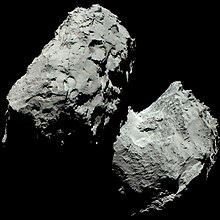67P/Churyumov–Gerasimenko
Appearance
67P/Churyumov–Gerasimenko (abbreviated as 67P or 67P/C-G) is a Jupiter-family comet,[1] at first from the Kuiper belt,[2] with a current orbital period of 6.45 years, a rotation period of about 12.4 hours[3] and a maximum speed of 135,000 km/h (38 km/s; 84,000 mph).[4] Churyumov-Gerasimenko is about 4.3 by 4.1 km at its longest and widest dimensions.[5] It was first followed on photographic plates in 1969 by Soviet astronomers Klim Ivanovych Churyumov and Svetlana Ivanovna Gerasimenko, after whom it is named.[6]

It latestly came to perihelion (closest approach to the Sun) on 2 November 2021,[7][8][9] and will next come to perihelion on 9 April 2028.[3]
References
[change | change source]- ↑ "Department of Physics, UCF". Physics. Retrieved 2022-12-01.
- ↑ Seth, Borenstein (10 December 2014). "The mystery of where Earth's water came from deepens". AP NEWS. Retrieved 2022-12-01.
- ↑ 3.0 3.1 "NASA". NASA. Archived from the original on 2022-04-23. Retrieved 2022-12-01.
- ↑ "Frequently asked questions". www.esa.int. Retrieved 2022-12-01.
- ↑ "Bigger than you think! Comet 67P compared to cities. HD". www.youtube.com. Retrieved 2022-12-01.
- ↑ Both names are stressed on their penultimate syllable. In Ukrainian, the pronunciations are approximately churyúmow herasiménko, with the v pronounced like an English w and the g like an h.
- ↑ "67P/Churyumov-Gerasimenko". www.aerith.net. Retrieved 2022-12-01.
- ↑ "IAU Minor Planet Center". minorplanetcenter.net. Retrieved 2022-12-01.
- ↑ Kazuo, Kinoshita (7 May 2009). "67P/Churyumov–Gerasimenko". Comet Orbit. Retrieved 2022-12-01.
